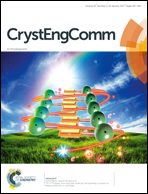Preparation, structure and characterization of a series of vanadates†
Abstract
A series of compounds based on vanadate, [Zn(1,10-phen)3][Zn(dap)2]0.5[Zn(dap)2(H2O)]2[VV6VIV10O38Cl]·2H2O (1), [Ni(im)6]3[VV7VIV8O36Cl]·17H2O (2), [Zn(2,2′-bpy)3]2[H2VV10O28]·6H2O (3), [Fe(Phen)3]3[V16O39Cl]·8.5H2O (4), [Zn(2,2′-bpy)]3[V15O36Cl] (5), [Co(2,2′-bpy)]3[V15O36Cl] (6), [Ni(en)2]3[V18O42Cl]·18H2O (7), [Cd(2,2′-bpy)2]2[V4O12]·0.5H2O (8), [Ni(2,2′-bpy)3]2[V4O12]·11H2O (9), [Zn(2,2′-bpy)3][V4O12]·11H2O (10) and [Ni(phen)3]2[V4O12]·12H2O (11) (1,10-phen = 1,10-phenanthroline, dap = 1,2-propanediamine, 2,2′-bpy = 2,2′-bipyridine, im = imidazole), has been synthesized under hydrothermal conditions and characterized using IR, UV-vis, XRD, ESR, elemental analysis and crystal structure analysis. Out of the eleven compounds, 1–3 and 11 are novel. Compound 1 is based on [V16O38Cl]7− anions and [Zn(dap)2]2+ and [Zn(dap)2(H2O)]2+ cations, forming a novel dimer of cluster supported coordination complexes. Compound 2 has a supramolecular structure based on [V15O36Cl]6− anions (V15) and [Ni(im)6]2+ cations. Compound 3 also has a supramolecular structure, which is constructed from [H2V10O28]4− and [Zn(2,2′-bpy)3]2+ cations. Compound 11 is formed by [V4O12]4− clusters and [Ni(phen)3]2+ cations. Compounds 4–10 are also based on vanadate and are not new compounds. Here, we investigate the catalytic properties of these eleven compounds, and the photocatalytic properties of some of these compounds.



 Please wait while we load your content...
Please wait while we load your content...